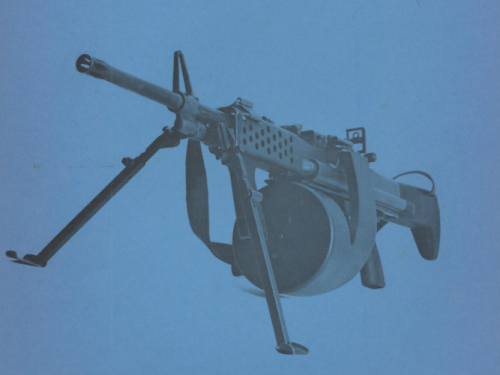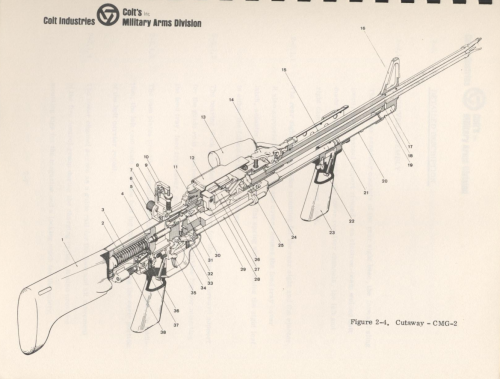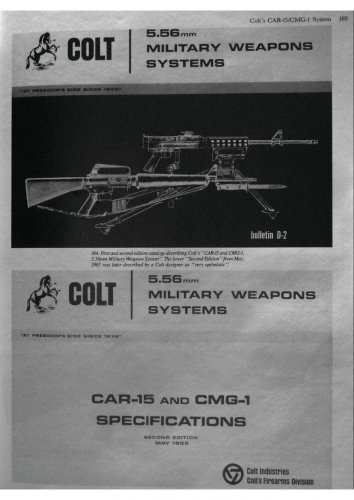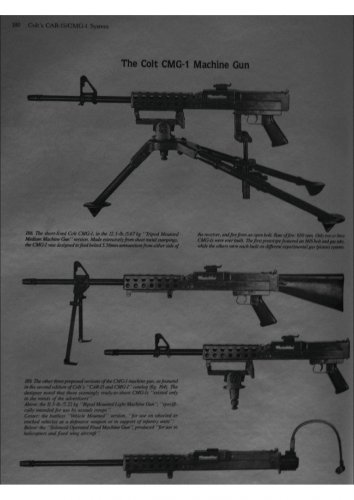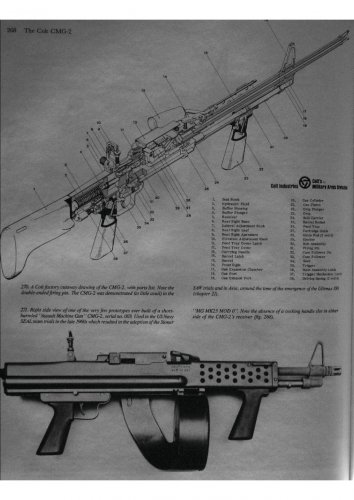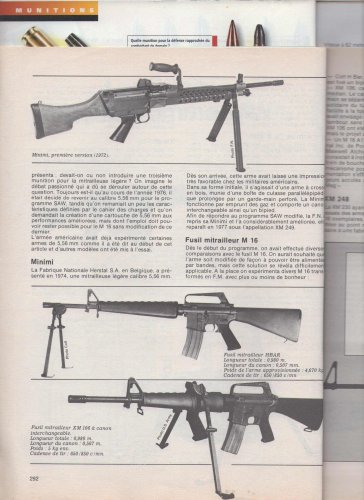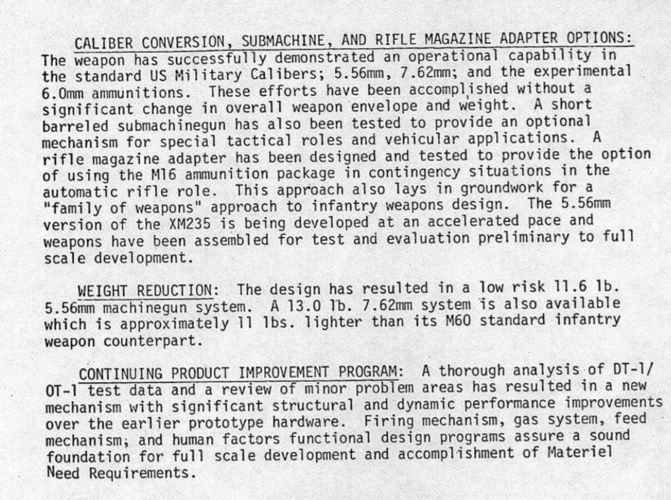CMG-2 and Stoner 63 were both doomed when the US Army, for whatever reasons, demurred on a 5.56 LMG for Vietnam. Both LMG were flawed but had a lot of potential, especially given the specifics of that conflict. Even if the Army had opted for what I guess we'd now call a SAW, the SEAL's preference for the Stoner didn't bode well for the CMG-2 . . .
We've seen that the Stoner 63 had a lot of development potential (63A1 on to the Stoner / ARES Model 86 on through the Stoner / Knight’s Model 96) but it's entirely possible that Forgotten Weapons summary of the CMG-2, "With more development, it could have been a pretty good weapon", is correct.
The US army threw away it's chances at an absolutely superb 5.56 belt fed (that also had a 7.62 NATO conversion developed and working) in the xm235/xm248 which eclipsed both the 63 and cmg2 in pretty much every way. Hell it even WON the SAW competition only to have the army go with the vastly inferior FN gun which we're now stuck with endless iterations of that get progressively more expensive and worse as the decades pass...
The mk48 and the FN version of the 240L both have had hilarious amounts of money and development dumped into them in order to finally get them to meet the contractual minimum service life round counts utterly in vain.
And now the army in it's infinite wisdom, after also rejecting a better 80% cheaper 50 bmg gun designed by the same team who did the 235/248 in the 80's is once again handing FN money to "lightweight the m2" based on "their successful work with mk46 mk48 and m240L" (the mk46 being the only one even remotely considerable as a success and even that has disturbingly low receiver life)
This series of bad decisions through the 70's and early 80's is what got us to this point where we keep paying FN in the hopes that this time it will be different because there's effectively almost no other options...
Some of you may object and bring up the new sig beltfeds and the knights LAMG or even worse you'll bring up the FN evolys (which if they make the mistake of buying it this time after ngsw rejected it once, socom rejected it an additional time, euro specops also rejected it after pouring more money into it, and FN abandoning the patents for two years until they found out ngsw was a trashfire and drug it back out)
1. The sig belt feds may be ok but their recoil reduction strategy flat doesn't work currently. (Probably because their designer's good work is still owned by GD and he was having to work around his own prior art as he was involved in xm307 xm806 the lwmmg and more)
2. Knight's badly bungled the LAMG and AMG and the guns are at best only suitable for socom like groups who can afford to constantly buy new guns every couple years because there's serious durability issues baked in.
3. The evolys is a trashfire that still doesn't make the grade which is why we see it's configuration continuously changing between every defense expo and PR blitz. But that's not even the worst of evolys' problems! Because it's also going to be ridiculously expensive and for the foreseeable future only be able to be manufactured in relatively small lots due to requiring extensive use of high end metal printing which no one in this industrial sector has the real capacity to do in quantity. (Delta P is essentially maxing out the entire gun industry's metal printing resources just trying to make enough suppressors for the ngsw evaluation program! And a can just on size alone is far easier and faster to print than an MG receiver)
The sad reality is we have all but pissed away our gun r&d complex and are now paying obscene amounts to bad contractors to jog in place.
And the actual good stuff that's out there like the Barrett 240L entry and it's lws version both of which have a service life at least as long as a 240 golf while having significantly reduced weights languishes and only sees sales to foreign customers.
We have unfortunately brought all this on ourselves and are left with a bunch of very bad but excessively expensive "options" none of which even match much less exceed designs we failed to adopt in the late 70's and early 80's.
The XM-235/238 got wrapped up in the 6mm experiment, another case of the best being the enemy of the good enough. The Army could have specified a heavier bullet to get longer ranged performance (Colt had already worked with 68 grain and Mauser-IWK with 77 grain) and gotten longer range without a new caliber. Instead they wasted time and money on a new 6mm round optimized for the SAW role, then used the 6mm requirement to disqualify both the Stoner and the CGM-2, then cancelled the 6mm entirely when reality reared it's ugly head.
How those guns would have done against the XM-235/238 is an interesting question, but one of the big things about the XM-235 was that it was designed to shoot very smoothly for improved accuracy, something the Stoner already excelled at (see the test fire video here:
View: https://www.youtube.com/watch?v=8LVWNGRjD0g
).
As for Stoner durability, maybe that is an issue. I'd argue that in peacetime normal troops don't fire enough ammunition for it to be an issue, and, in wartime, and for spec ops in peacetime, the cost of replacing LMG every 10 years instead of every 20 years is meaningless. Also the SEALS kept the Stoners in service for about 20 years, which included wartime service, so they had some level of durability.
Also I'm having a few issues trying to respond to you in a way that makes sense as you are mixing together the attributes of multiple guns without meaning to which makes sending a cogent response tricky.
For one you're bringing up the stoner 63 which has nothing to do with what I posted. The knights LAMG and AMG are based off the later stoner 86 design which is a completely different gun than the 63 to a point where bringing up the 63 at all muddies the water on it's own. You seem a little unclear on them being totally different designs where the only relationship between them and the LAMG and AMG is how many lugs are on the bolt face. Additionally you seem to be rolling the LAMG and amg's pseudo constant recoil features into the stoner 63 which it did not have.
I'll Grant you that the 63 is a very nice shooting gun though, however the 235 and 248 shoot competitively with the barely introduced In the last 5 years knights LAMG and AMG and substantially better than the 63. The 235/248 is the waypoint between guns like the stoner 63 and Sullivan's constant recoil ultimax. While not full constant recoil like the ultimax (neither are the knights guns because that introduces penalties on your design they couldn't afford and meet weight) the 235/248's were built to be substantially softer shooting at a much lower weight than contemporary competitors like xm249 etc and would be broadly competitive even now with the best of what fn and knights can offer while still being almost frighteningly cheaper, more manufacturable, and conducive to how we do warfare now
Second you're bringing up the xm235/248 having 6mm saw versions as if they're the only versions when the xm235 was built in 5.56 6 saw and 7.62 NATO AND was one of the guns who did the testing on the various improved 5.56 loadings you keep bringing up which implies that it worked just fine with all of them (considering that the only change necessary to shoot the various loadings is a change in rifling twist and rodman labs was one of the places doing studies on barrels and optimized twist this also doesn't track)
I'll absolutely grant that ALL of this is very niche information which very few people have a good handle on but it does make it slightly more difficult to respond.
If you want I can break down the differences between the stoner 63 and the 86/knights LAMG and AMG as well as the differences between the various fn guns I listed.
CMG-2 and Stoner 63 were both doomed when the US Army, for whatever reasons, demurred on a 5.56 LMG for Vietnam. Both LMG were flawed but had a lot of potential, especially given the specifics of that conflict. Even if the Army had opted for what I guess we'd now call a SAW, the SEAL's preference for the Stoner didn't bode well for the CMG-2 . . .
We've seen that the Stoner 63 had a lot of development potential (63A1 on to the Stoner / ARES Model 86 on through the Stoner / Knight’s Model 96) but it's entirely possible that Forgotten Weapons summary of the CMG-2, "With more development, it could have been a pretty good weapon", is correct.
The US army threw away it's chances at an absolutely superb 5.56 belt fed (that also had a 7.62 NATO conversion developed and working) in the xm235/xm248 which eclipsed both the 63 and cmg2 in pretty much every way. Hell it even WON the SAW competition only to have the army go with the vastly inferior FN gun which we're now stuck with endless iterations of that get progressively more expensive and worse as the decades pass...
The mk48 and the FN version of the 240L both have had hilarious amounts of money and development dumped into them in order to finally get them to meet the contractual minimum service life round counts utterly in vain.
And now the army in it's infinite wisdom, after also rejecting a better 80% cheaper 50 bmg gun designed by the same team who did the 235/248 in the 80's is once again handing FN money to "lightweight the m2" based on "their successful work with mk46 mk48 and m240L" (the mk46 being the only one even remotely considerable as a success and even that has disturbingly low receiver life)
This series of bad decisions through the 70's and early 80's is what got us to this point where we keep paying FN in the hopes that this time it will be different because there's effectively almost no other options...
Some of you may object and bring up the new sig beltfeds and the knights LAMG or even worse you'll bring up the FN evolys (which if they make the mistake of buying it this time after ngsw rejected it once, socom rejected it an additional time, euro specops also rejected it after pouring more money into it, and FN abandoning the patents for two years until they found out ngsw was a trashfire and drug it back out)
1. The sig belt feds may be ok but their recoil reduction strategy flat doesn't work currently. (Probably because their designer's good work is still owned by GD and he was having to work around his own prior art as he was involved in xm307 xm806 the lwmmg and more)
2. Knight's badly bungled the LAMG and AMG and the guns are at best only suitable for socom like groups who can afford to constantly buy new guns every couple years because there's serious durability issues baked in.
3. The evolys is a trashfire that still doesn't make the grade which is why we see it's configuration continuously changing between every defense expo and PR blitz. But that's not even the worst of evolys' problems! Because it's also going to be ridiculously expensive and for the foreseeable future only be able to be manufactured in relatively small lots due to requiring extensive use of high end metal printing which no one in this industrial sector has the real capacity to do in quantity. (Delta P is essentially maxing out the entire gun industry's metal printing resources just trying to make enough suppressors for the ngsw evaluation program! And a can just on size alone is far easier and faster to print than an MG receiver)
The sad reality is we have all but pissed away our gun r&d complex and are now paying obscene amounts to bad contractors to jog in place.
And the actual good stuff that's out there like the Barrett 240L entry and it's lws version both of which have a service life at least as long as a 240 golf while having significantly reduced weights languishes and only sees sales to foreign customers.
We have unfortunately brought all this on ourselves and are left with a bunch of very bad but excessively expensive "options" none of which even match much less exceed designs we failed to adopt in the late 70's and early 80's.
The XM-235/238 got wrapped up in the 6mm experiment, another case of the best being the enemy of the good enough. The Army could have specified a heavier bullet to get longer ranged performance (Colt had already worked with 68 grain and Mauser-IWK with 77 grain) and gotten longer range without a new caliber. Instead they wasted time and money on a new 6mm round optimized for the SAW role, then used the 6mm requirement to disqualify both the Stoner and the CGM-2, then cancelled the 6mm entirely when reality reared it's ugly head.
How those guns would have done against the XM-235/238 is an interesting question, but one of the big things about the XM-235 was that it was designed to shoot very smoothly for improved accuracy, something the Stoner already excelled at (see the test fire video here:
View: https://www.youtube.com/watch?v=8LVWNGRjD0g
).
As for Stoner durability, maybe that is an issue. I'd argue that in peacetime normal troops don't fire enough ammunition for it to be an issue, and, in wartime, and for spec ops in peacetime, the cost of replacing LMG every 10 years instead of every 20 years is meaningless. Also the SEALS kept the Stoners in service for about 20 years, which included wartime service, so they had some level of durability.
Also I'm having a few issues trying to respond to you in a way that makes sense as you are mixing together the attributes of multiple guns without meaning to which makes sending a cogent response tricky.
For one you're bringing up the stoner 63 which has nothing to do with what I posted. The knights LAMG and AMG are based off the later stoner 86 design which is a completely different gun than the 63 to a point where bringing up the 63 at all muddies the water on it's own. You seem a little unclear on them being totally different designs where the only relationship between them and the LAMG and AMG is how many lugs are on the bolt face. Additionally you seem to be rolling the LAMG and amg's pseudo constant recoil features into the stoner 63 which it did not have.
I'll Grant you that the 63 is a very nice shooting gun though, however the 235 and 248 shoot competitively with the barely introduced In the last 5 years knights LAMG and AMG and substantially better than the 63. The 235/248 is the waypoint between guns like the stoner 63 and Sullivan's constant recoil ultimax. While not full constant recoil like the ultimax (neither are the knights guns because that introduces penalties on your design they couldn't afford and meet weight) the 235/248's were built to be substantially softer shooting at a much lower weight than contemporary competitors like xm249 etc and would be broadly competitive even now with the best of what fn and knights can offer while still being almost frighteningly cheaper, more manufacturable, and conducive to how we do warfare now.
Second you're bringing up the xm235/248 having 6mm saw versions as if they're the only versions when the xm235 was built in 5.56 6 saw and 7.62 NATO AND was one of the guns who did the testing on the various improved 5.56 loadings you keep bringing up which implies that it worked just fine with all of them (considering that the only change necessary to shoot the various loadings is a change in rifling twist and rodman labs was one of the places doing studies on barrels and optimized twist this also doesn't track)
I'll absolutely grant that ALL of this is very niche information which very few people have a good handle on but it does make it slightly more difficult to respond.
If you want I can break down the differences between the stoner 63 and the 86/knights LAMG and AMG as well as the differences between the various fn guns I listed.
I appreciate the detailed feedback but I wasn't trying to make as many points as it may have sounded like. Roughly in order:
- I brought up the Stoner 63 because both it and the CMG-2 were disqualified from the SAW trials because they weren't available in 6mm. They should have been allowed in the competition, which reverted to 5.56mm anyway. Note that I am not saying they would have won, just that they should have been in (the Stoner 63 at least as a "control" weapon, since there was actual combat experience with it).
- I brought up the Stoner 63 - 63A1 - ARES Model 86 - Stoner / Knight’s Model 96 development line only to illustrate that the gun had development potential. I did not intend to imply anything else and I understand that the guns are not interchangeable and were available at different times.
- My point about the Stoner 63 being very smooth when shooting was just that. I am not denying that other guns shoot well, or even smoother, sometimes using different design approaches. I was saying that any advantage they might have over the Stoner is less than what would be over any other Stoner contemporary LMG.
- It was not my intent to sound like I was saying that the XM-235/248 were only available in 6mm. My point was only about how the army's foray into 6mm warped the SAW competition and wasted time and money that could have been spent on getting a "good enough" 5.56mm SAW in service, preferably with a 68-77 grain loading. Maybe the right choice was a 5.56mm XM-235/248, and maybe the 7.62mm version was great; I'm just saying that the 6mm version was a waste of time and money.
- Ref "the way seals kept their very few guns running was by sitting on a massive mountain of spares as well as extensive and frequent rebuilds which normal line unit guns can't and wouldn't get", I'm not arguing with you. My point was that in peacetime the SEALS shoot as much ammo in a year as a line infantry unit does in what, 5 years? 10 years? so spec ops have the resources to keep them running and line infantry has much less wear and tear, so either way you have an acceptable service life. I'm saying "acceptable", not "good", not "great": my only point here is that this should not disqualify the Stoner from consideration, not that it wasn't an issue with the design.
- Ref "If you want I can break down the differences between the stoner 63 and the 86/knights LAMG and AMG as well as the differences between the various fn guns I listed." Please do. I'd be very interested in the information you have about the Stoner/ARES/Knight's progression in particular and it would be much appreciated.
Ok yeah I understand exactly what you were saying now.
Personally I am a huge fan of the 63 and yes both it and cmg2 should have been included in the SAW program, which was a badly run disaster from start to finish.
There are two incidents besides the DQ of perfectly good guns that illustrate this.
1. Early in the program when they did a spectrum study and design analysis of what the ideal cartridge would be for this application the analysis came up saying a cartridge my friends and I have dubbed 5.56 Saw was the ideal way to go. They did actually make barrels and rounds for this and did some limited testing which is lost to the world now with a very superlative beast of a 5.56 round. (think Russian 6x49 universal but in 5.56)
But various people did not like 5.56 being the answer so they forced a restart and the design of the various 6 SAW cartridges (there's several not just one)
2. As the program reached the final decision point they did analyses of the remaining contenders, came to the conclusion that the xm248 was the better gun, was cheaper, and then promptly picked the m249 citing a "lack of confidence in the existing American machine gun establishment to successfully manufacture the 248 as the reason for picking the heavier, more expensive, and worse gun.
The cost analysis and final evaluation stuff is available at the small arms review archive and it tells the story pretty damningly.
This is why we get these interesting little asides from contemporary sources about the army really wanting the magazine feed option to not require a single pin adapter install or the nebulous and entirely unsupported "somehow Philco bungled the 248 and it did badly in the final trials" assertions which aren't actually supported by the evidence.
What's most frustrating about this is the xm248 or a different prime contractors spin on the original rodman work could have provided us with a suite of both 5.56 and 7.62 guns that were cheaper lighter and better suited to current needs had some people not made very bad decisions then..
Now onto the modern knights incarnation of the stoner 86 or whatever we want to call it. The bolt carrier runs on bare aluminum guide rails machined into the receiver walls and as we know aluminum, even really high end aluminum, doesn't "fatigue" like steel... Once it reaches its threshold stress values it just kinda dustifies.
Due to the nature of even the less stressful Knight's belt feed system this is going to result in these guns having pretty short lifespans, especially the 7.62 version.
The other "new MG designs" in competition for various programs right now are all remarkably troubled in some way or another or will wind up being too expensive and requiring things like high end 3d metal printing to be manufactured in real quantities (fn evolys).
The bad decisions from that era very much haunt us today m

